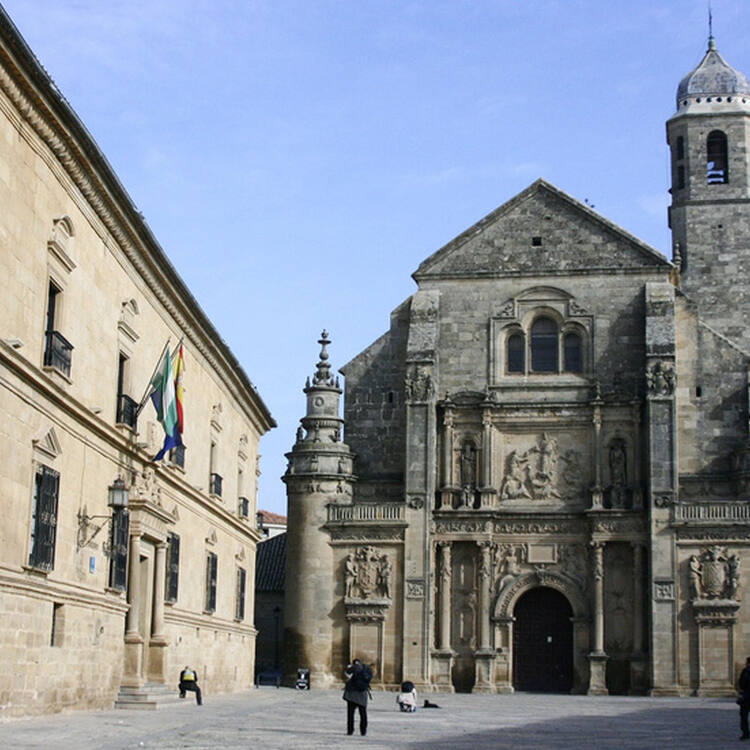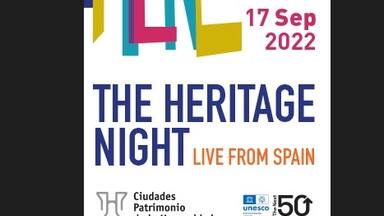Renaissance Monumental Ensembles of Úbeda and Baeza
Renaissance Monumental Ensembles of Úbeda and Baeza
The urban morphology of the two small cities of Úbeda and Baeza in southern Spain dates back to the Moorish 9th century and to the Reconquista in the 13th century. An important development took place in the 16th century, when the cities were subject to renovation along the lines of the emerging Renaissance. This planning intervention was part of the introduction into Spain of new humanistic ideas from Italy, which went on to have a great influence on the architecture of Latin America.
Description is available under license CC-BY-SA IGO 3.0
Ensembles monumentaux Renaissance de Úbeda et Baeza
Les deux petites villes d’Úbeda et Baeza, dans le sud de l’Espagne, ont été dotées de leur forme urbaine à la période mauresque, au IXe siècle, et après la Reconquista au XIIIe siècle. Elles ont connu d’importants changements au XVIe siècle, lorsque les villes ont subi des travaux de rénovation dans l’esprit de la Renaissance. Ces initiatives urbanistiques furent le reflet de l’introduction en Espagne des idées humanistes venues d’Italie. Ces idées ont également exercé une influence importante sur l’architecture d’Amérique latine.
Description is available under license CC-BY-SA IGO 3.0
مجمّعات فنيّة نهضويّة في أوبيدا وبايزا
نالت مدينتا أوبيدا وبايزا الوقعتان جنوب اسبانيا شكلهما الحضري في الحقبة المغربيّة في القرن التاسع وبعد الفتح في القرن الثالث عشر. ولقد سجّلت تغيّرات مهمّة في القرن السادس عشر عندما خضعت المدن لأعمال ترميم على الطراز النهضوي. وشكّلت هذه البوادر الحضريّة انعكاساً لاجتياح الأفكار الإنسانيّة المصدّرة من إيطاليا إلى اسبانيا. كما مارست هذه الأفكار تأثيراً مهمّاً أيضاً على هندسة أمريكا اللاتينيّة.
source: UNESCO/CPE
Description is available under license CC-BY-SA IGO 3.0
乌韦达和巴埃萨城文艺复兴时期的建筑群
在西班牙南部坐落着两个小城——乌韦达和巴埃萨,对于当地城市形态学的研究可以追溯到公元9世纪摩尔人统治时期以及公元13世纪的收复领土时期。到了公元16世纪,随着文艺复兴运动的发展,当地也出现了文艺复兴的形势,使这两个小城得到了重大发展。这种有计划的影响其实就是新人文主义思想从意大利被介绍到了西班牙,这一思想后来从西班牙带到了拉丁美洲,对那里的建筑一直产生着巨大影响。
source: UNESCO/CPE
Description is available under license CC-BY-SA IGO 3.0
Монументальные ансамбли Возрождения в городах Убеда и Баэса
Городская морфология двух небольших городов – Убеда и Баэса, расположенных в южной Испании, сложилась во времена мавров в IХ в. и реконкисты в XIII в. Города активно развивались в XVI в. – тогда они обновлялись в соответствии со стилистикой Возрождения. Эти нововведения были обусловлены приходом в Испанию из Италии новых гуманистических идеалов, которые в дальнейшем оказали большое влияние на архитектуру Латинской Америки.
source: UNESCO/CPE
Description is available under license CC-BY-SA IGO 3.0
Conjuntos monumentales renacentistas de Úbeda y Baeza
La configuración urbana de las dos pequeñas ciudades de Úbeda y Baeza, situadas en el sur de España, data de los periodos de la dominación árabe (siglo IX) y de la Reconquista (siglo XIII). En el siglo XVI, ambas ciudades experimentaron cambios importantes, al efectuarse obras de renovación inspiradas en el estilo del Renacimiento. Estas transformaciones urbanísticas se debieron a la introducción en España de las ideas humanistas procedentes de Italia y ejercieron una influencia importante en la arquitectura de América Latina.
source: UNESCO/CPE
Description is available under license CC-BY-SA IGO 3.0
ウベダとバエーサのルネサンス様式の記念碑的建造物群
スペイン南部アンダルシア地方にある2つの小都市ウベダとバエーサは、9世紀のムーア時代と13世紀のレコンキスタ(国土回復運動)後に都市として形成された。アラブ・アンダルシア的な都市構造と、より北方的な影響の強い宗教的・公共建造物や宮殿などが世界遺産の対象。16世紀のルネサンスとともに町は修復されて発展を遂げた。修復計画に際してイタリアから人文主義の思想がもたらされ、この思想はラテン・アメリカの建築デザインにまで影響をおよぼした。source: NFUAJ
Monumentale Renaissance ensembles van Úbeda en Baeza
De twee kleine steden Úbeda en Baeza in het zuiden van Spanje dateren uit de Moorse 9e eeuw en uit de Reconquista in de 13e eeuw. De steden maakten een belangrijke ontwikkeling door tijdens de 16e eeuw toen ze gerenoveerd werden naar de maatstaven van de Renaissance. De nieuwe architectonische opvattingen maakten deel uit van de humanistische ideeën uit Italië die in Spanje geïntroduceerd werden in die tijd. Hun renaissance bouwstijl en stadstructuur hebben grote invloed gehad op de architectuur in Latijns Amerika.
Source: unesco.nl
Outstanding Universal Value
Brief synthesis
The Renaissance Monumental Ensembles of Úbeda and Baeza lie in the two Andalusian cities of Úbeda and Baeza which are 9 km away from each other. The inscribed property in Úbeda is 4.2 ha and the property in Baeza is 4.8 ha. Both parts have buffer zones and the two towns are linked by a rural protection area of 44.2 km2.
The respective monumental ensembles attained their most unique constructive expressions during the Renaissance period. Úbeda developed outstanding noble architecture; Baeza turned into an important ecclesiastic and educational centre.
The most complete example of their architectural identity is the Plaza Vázquez de Molina in Úbeda, surrounded by civil and religious buildings built from 1530 to 1580, with special mention to the funeral chapel of El Salvador and the Vázquez de Molina Palace (today’s Town Hall). These form the greatest Renaissance architecture ensemble in Spain and one of the most important in Europe.
The main elements of the Baeza ensemble are the Cathedral and the Santa María Square, the old Seminary and the University. Known for its religious and educational uses, it became the site of the International University of Andalusia in the 1970s.
Úbeda and Baeza are early examples in Spain of the introduction of the Italian Renaissance design criteria. Furthermore, their considerable influence in Latin America has been well documented. The introduction of Renaissance interventions in an urban area originating from an Islamic period is also of interest.
The coexistence of cultures (Christian, Islamic and Jewish) favoured freedom and opening up to other influences, contributing an originality of artistic expression with great implications in Latin America.
This region has both Islamic roots and an intense medieval tradition in stonework. Stonemasonry was enriched by Andrés de Vandelvira, as described in the Libro de Traças de Cortes de Piedra (“Book of Stone-Cutting Designs”), written by his son Alonso, and considered the best compendium of Stereotomy in Europe until the end of the 17th Century. It had great influence on Latin American architecture.
The masters of Úbeda-Baeza greatly contributed to universal Renaissance culture, complementing Italian constructions with particular Islamic influences and the systematic use of stonemasonry.
Criterion (ii): The 16th-century examples of architectural and urban design in Úbeda and Baeza were instrumental in introducing the Renaissance ideas to Spain. Through the publications of Andréa Vandelvira, the principal project architect, these examples were also diffused to Latin America.
Criterion (iv): The central areas of Úbeda and Baeza constitute outstanding early examples of Renaissance civic architecture and urban planning in Spain in the early 16th century.
Integrity
The Renaissance Monumental Ensembles of Úbeda and Baeza reflect the important transformations which occurred to these cities with their Islamic past and later Mudéjar tradition, during the 16th Century, with the advent of the Renaissance. Thus, they comprise an urban dimension, which along with the architectural one, are the essential attributes of their Outstanding Universal Value.
Úbeda and Baeza have retained a large part of their historic fabric. The walled town of Úbeda maintains the overall character of traditional housing developed since the Middle Ages; only the major streets were renovated in the 19th century, and, besides, most commercial activities have been undertaken outside the medieval walls. In Baeza, the eastern part of the old town is best preserved, while the western part has some recent constructions near the former Alcázar site which, like that of Úbeda, has remained vacant. The property includes leading Renaissance monumental elements.
Baeza Cathedral reflects the juxtaposition of different styles: the primitive mosque that has Gothic-Moorish elements and subsequent Renaissance influences of Vandelvira; the Church and particularly the Sacristy of El Salvador and the Palaces of Vázquez de Molina and Deán Ortega in Úbeda, also by Vandelvira, have been kept in their original state, except for necessary changes carried out for their present-day use. Most of the remaining buildings from different periods have the mark of the Renaissance style.
The condition of both ensembles is excellent, given their highly institutional character. In Úbeda, they are used for several administrative headquarters, religious purposes and a Parador (state-run hotel). In the ensemble of Baeza some buildings have been renovated to house the International University of Andalusia, such as the old Seminary and the marvellous Palace of Jabalquinto.
In addition to architectural integrity, there is the perfect urban planning of the public spaces that contain these buildings. Some of these spaces have been renovated and redeveloped in keeping with the original work.
This area has low seismic hazard in absolute terms, though the risk is a little higher here than in the rest of the Spanish territory. Pollution problems from a nearby factory in Baeza are being resolved.
Authenticity
The importance of the Renaissance Monumental Ensembles of Úbeda and Baeza in their surrounding territories is an exceptional example of the complementary duality held by these two cities in the region of La Loma, since the 16th century (period of their socioeconomic growth).
This duality can be most clearly seen through their monumental ensembles, which are outstanding examples of the distribution of urban functions. Both monumental ensembles of Baeza (with public, ecclesiastic and educational functions) and Úbeda (with noble and palatial functions) have a Renaissance urban plan which has acquired its own identity and has continuing authenticity of form and design.
Material authenticity also stems from the historic buildings in the two inscribed areas. Belonging to different styles and periods (the Renaissance style prevailing), these possess a high degree of authenticity, which can be seen not only in their actual façades but also in their architectural style, representing the different social classes and explaining their building heritage.
Protection and management requirements
The existence of urban and heritage protection mechanisms ensures that the Outstanding Universal Value is maintained. The inscribed areas form part of zones which have been declared Historic Ensembles, and thus come under Special Protection Plans and Inventory. Moreover, individual buildings have the maximum level of protection existing in both regional and state Heritage Legislation, as they have been declared Property of Cultural Interest under the category of Monuments.
The Special Protection Plans and Inventory lay out the protection conditions for the maintenance of their urban and architectural structure and of their traditional urban image. These Plans have a broad urban content and not only protect the values using specific regulations but they propose urban restoration and recovery.
The Special Plans have been endorsed by the respective Local General Plans: Úbeda (1997 and 2009 Advance Review) and Baeza (2011 Review), which promote the value of these Monumental Ensembles as functional centres and symbolic spaces, as well as protecting the surrounding countryside. The planning respects the present-day use of the Monumental Ensembles and contemplates actions to improve the historic centres: a functional revival and improvement of conditions of access, pedestrian mobility and parking.
By means of the co-operation agreement of 1999, Úbeda and Baeza Town Councils coordinated and developed heritage management concerning conservation and restoration, culture and tourism, setting out sustainable interventions to recover their respective historic centres.
The respective historic centres (Úbeda 2005 and Baeza 2006) were declared State-aided Restoration Areas. This has led to many public interventions: improving urban planning of public spaces, restoring the city walls and unique buildings, restoring houses and associated infrastructure. Since March 2009, this liaison has been carried out by means of the “Association for Tourist Development of Úbeda and Baeza”, through the Sustainable Tourism Plan “Úbeda/Baeza, the Open Renaissance Museum”.
Different actions are necessary in each city, in particular the Comprehensive Plan of Accessibility, the creation of Park and Ride areas, traffic restrictions, urban development of public spaces, and heritage signposting. The Renaissance Monumental Ensembles of Úbeda and Baeza will thus become a heritage management model for other medium-sized Andalusian cities.Links
-
Baeza Town Hall - Twitter page (X)
-
Baeza Town Hall - Instagram page
-
Baeza Town Hall - Facebook page
-
Tourism in Baeza
-
Andalusia - Úbeda and Baeza
-
Twitter page (X)
-
Facebook page
-
Úbeda - World Heritage Cities of Spain
-
Tourism in Úbeda (in Spanish)
-
Ministry of Culture and Sports (in Spanish)
-
Baeza Town Hall (in Spanish)
-
Úbeda Town Hall (in Spanish)


